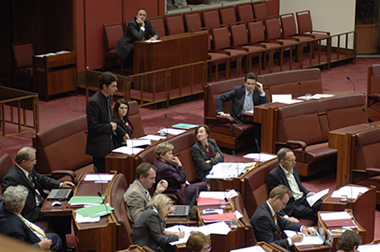186 The call to speak
-
A senator desiring to speak shall rise and address the President.
-
Subject to the practices of the Senate relating to the call to speak, when 2 or more senators rise together to speak, the President shall call upon the senator who, in the President’s opinion, first rose in the senator’s place.
Amendment history
Adopted: 19 August 1903 as SOs 394 and 396 (corresponding to paragraphs (1) and (2)) but renumbered as SOs 389 and 391 for the first printed edition
1989 revision: Old SOs 403 and 405 combined into one, structured as two paragraphs and renumbered as SO 186; removal of reference in paragraph (1) to rising “uncovered” (see SO 185) and of gender-specific pronouns in paragraph (2); addition of qualification, “subject to the practices of the Senate” in paragraph (2)
Commentary
As well as maintaining order, one of the principal duties of the Chair is to allocate the call to senators in debate. Taken literally, this standing order envisages the senator who, in the opinion of the Chair, is first to his or her feet being given the call. In reality, various practices have developed over the years and these are recognised in paragraph (2). For many debates and for questions without notice, the Chair has access to an informal list of prospective speakers compiled by the party whips. This is an unofficial list and does not bind the Chair.
The calling of senators in debate was examined by the Procedure Committee in its Second Report of 1991.[1] While conceding that it was not possible to formulate rules to cover all conceivable circumstances arising in debate, the committee endorsed the existing rules and practices as set out in a document circulated by the Deputy President, with the approval of the President, to all temporary chairs of committees on 24 November 1987, and incorporated in Hansard on 5 June 1991.[2]

Senator Ludlam (AG, WA) is on his feet and has the call (Photo courtesy of AUSPIC)
The document referred to practices identified in Presidential rulings:
-
senators are usually called from each side of the chamber alternately;
-
the call is given to the Leader of the Government in the Senate and the Leader of the Opposition in the Senate before other senators;
-
a minister in charge of a bill or other matter before the Senate is usually given the call before other senators.
It also identified the following practices:
-
an Opposition senator leading for the Opposition in relation to a bill or other matter before the Senate is usually given the call before other senators;
-
leaders of other non-government parties are usually given the call before other senators, subject to the foregoing practices;
-
senators who have a right to the call under these practices are discouraged from seeking it if that would have the effect of closing the debate and other senators wish to speak.[3]
These practices operate in descending order with each one subject to those preceding it. Any informal list of speakers is also regarded as subject to each of these practices.
The allocation of the call is an inherent role of the Chair and is not a ruling as such, liable to challenge under SO 198. This role is reinforced by the technology of the chamber. While the Chair’s microphone is live at all times, those of other senators are activated by a technician from a sound booth at the back of the chamber only when a senator has been given the call. A senator’s microphone is de-activated when the Chair announces that the senator’s time has expired.
When speaking, a senator is required to address the Chair. Presidential rulings have established that it is disorderly to address other senators directly across the chamber. Any such remarks must be directed to the Chair and must refer to other senators only in the third person. This is regarded as a technique to encourage courteous and civilized debate.
A senator must be in his or her seat to receive the call. For exceptions to this rule, see SO 48.